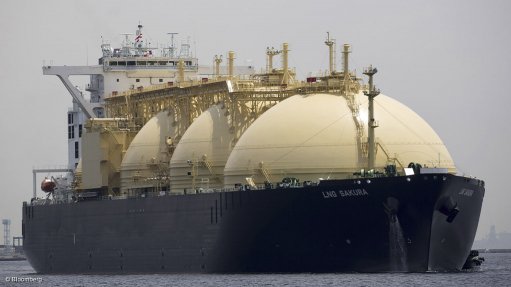
A new report on ‘The role of gas in South Africa’s path to net-zero’ argues in favour of a pathway based on the importation of liquefied natural gas (LNG), which it describes as “optimal” because it minimises the risk of stranded assets and gas infrastructure lock-in post-2040.
In addition, such a pathway is less complex and capital intensive than ones based on the possible exploration and development of domestic gas fields and/or the building of a pipeline to import gas from northern Mozambique.
Published by the National Business Initiative, Business Unity South Africa and the Boston Consulting Group, the report forms part of a broader research and consultative process on the decarbonisation of key sectors of the South African economy.
It concludes that gas can, if affordably supplied, play a role as a “transition fuel” to replace more emissions-intensive fossil fuels such as coal and diesel.
In addition, gas could complement battery storage to provide flexible capacity and enable a rapid scaling up of renewables, until alternative long-duration energy storage solutions and greener fuels become affordable.
The report assesses five possible pathways, including having no additional gas supply whatsoever – a scenario that is not recommended based on an analysis indicating that cumulative emissions would be 400 Mt to 600 Mt higher than under scenarios with additional gas supply.
Such an outcome is due, the reports explains, to the prolonged use of more carbon-intense fossil fuels such as diesel and coal, before greener alternatives become economically viable.
Other pathways assessed include both the building of a gas pipeline linking South Africa to the Rovuma gasfields in northern Mozambique and/or the development of domestic gas discoveries, such as Brulpadda and Luiperd.
It concludes, however, that the ‘LNG pathway’ would be the optimal supply option to meet South Africa’s gas demand and to address the supply constraints from the diminishing Pande-Temane reserves, South Africa’s only current major source of gas supply.
The report argues that the LNG pathway carries relatively low infrastructure and technology lock-in risks once demand ramps down post-2040, noting that gas will have to be phased out entirely by 2050 and replaced with greener alternatives for South Africa to achieve a net-zero-by-2050 target.
In addition, the capital expenditure required to install floating storage regasification unit (FSRU) infrastructure (R20-billion to R50-billion) and an inland pipeline (R25-billion to R50-billion) would be far lower than the R200-billion required for a pathway based on an importation pipeline and the development of domestic deposits.
That said, any new investments in gas infrastructure should consider the future repurposing of the assets to use green gases, such as green hydrogen blends and green hydrogen.
The negative impact on the trade balance associated with the LNG pathway, the reports states, would need to be offset by new green export industries, such as a South African e-fuels industry.
The report assumes that South Africa’s potential future gas demand will be driven by the four key sectors of electricity, synthetic fuels production, industry and transport.
It states that gas-to-power (GTP) plants will displace diesel and enable a high penetration of renewable energy in the power system by providing the flexible capacity to manage the long-duration intermittency that battery storage cannot currently address.
“As an alternative to diesel, the power sector can afford gas, for predominantly peaking capacity, at delivered prices of up to R300/GJ.”
Given this high affordability threshold, the report states that GTP plants could serve as a demand anchor to enable the optimal supply option for South Africa.
“It is therefore critical that energy planning policy gives clarity to the deployment, operating regime, and location of GTP plants beyond 2030.”
Should the LNG pathway be pursued, the report recommends a multi-hub approach with FSRUs in Richards Bay, Coega and Saldanha, as well as Matola, in southern Mozambique.
“In addition to Matola as a supply option, developing all three South African FSRUs in parallel emerges as the optimal supply scenario for South Africa.”
The report also urges the South African authorities to establish an enabling policy and commercial framework to procure gas on an aggregated basis and achieve economies of scale and enable supply infrastructure within the time and to the scale required.
However, risk of unconstrained demand and stranded supply infrastructure should also be actively managed.
“A detailed view on the gas supply-demand economics and affordability across all sectors should inform the Gas Master Plan which should, in turn, provide clarity on the long-term demand and preferred supply pathway for South Africa.
“Policy and specific stakeholder engagement platforms should also be leveraged to promote investment, drive public-private partnerships and bilateral relations with Mozambique, and to invest in research and development for solutions to address methane leakage and repurposing of gas infrastructure,” the report states.